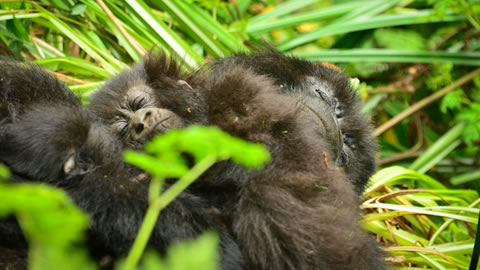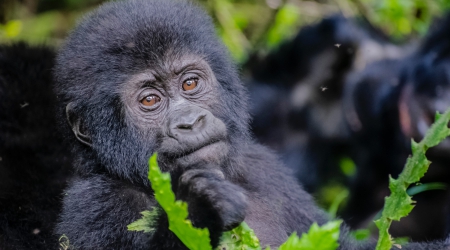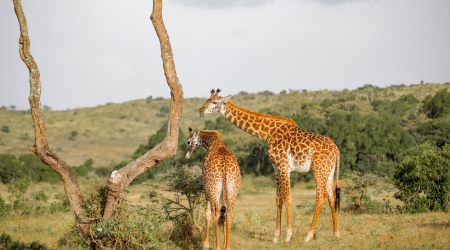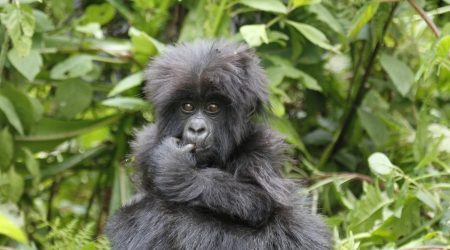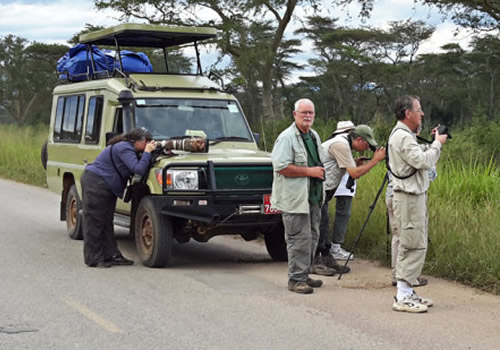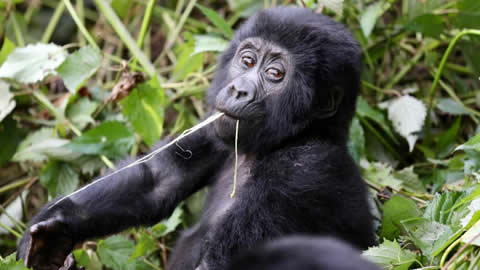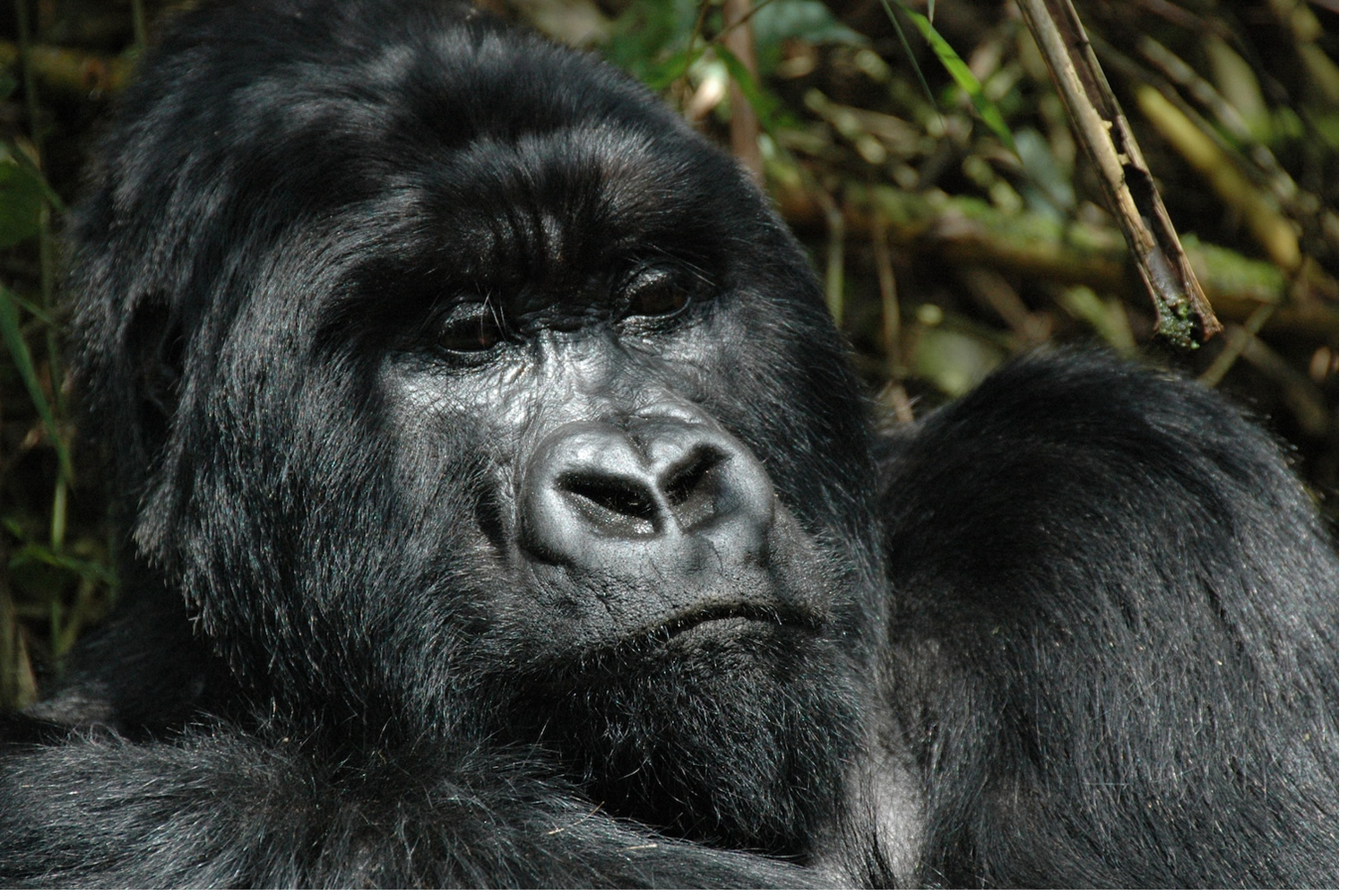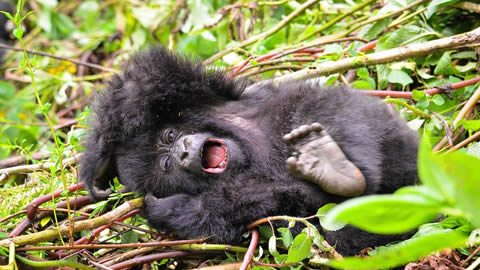[vc_row][vc_column width=”3/4″][vc_column_text]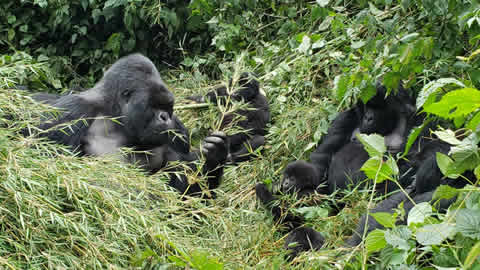
About the Lives of Mountain Gorillas: Mountain gorillas are subspecies of the Eastern gorillas that survive in high altitudes in the mountains at 8000-13000 feet above sea level. The name mountain gorilla was derived from where they live in the mountains. Mountain gorillas were once critically endangered but the status changed in 2018 as declared by International Union for Conservation of Nature (IUCN) though they remained endangered species in the Red unit book. The population of the mountain gorillas has had a stable increase from the past years and now it stands at more than 1000 in the whole world.
Mountain gorillas are shared in East and Central Africa on the slopes of Virunga ranges in volcanoes national park in Rwanda, Virunga national park in Democratic Republic of Congo, Mgahinga gorilla national park in Uganda, and Bwindi forest national park which hosts about 70% of the remaining mountain gorillas.
The first systematic study about Gorillas was not conducted until the 1920s when Carl Akeley of the American Museum of Natural History traveled to Africa. About the Lives of Mountain Gorillas,
After World War II, George Schaller was one of the first researchers to go into the field and study primates. In 1959, he conducted a systematic study of the mountain gorilla in the wild and published his work.
Years later, Dian Fossey conducted a much longer and more comprehensive study of the mountain gorilla on the slope of karisimbi mountain in volcanoes national park where she spent most of her time until she met her death in 1985. It was not until Dian Fossey published her work that many misconceptions and myths about gorillas were finally disproved, including the myth that gorillas are violent. Dian Fossey brought the plight of mountain gorillas on the international scene through her book “Gorillas in the mist”.
Until recently there was considered to be a single gorilla species, with three subspecies: the western lowland gorilla, the eastern lowland gorilla, and the mountain gorilla. There is now agreement that there are two species with two subspecies each. More recently it has been claimed that a third sub-species exists in one of the species. About the Lives of Mountain Gorillas, The separate species and subspecies developed from a single type of gorilla during the Ice Age when their forest habitats shrank and became isolated from each other. There are some facts about the lives of the gorillas and these are;
Gorillas are the largest species of primates. They are ground-dwelling, predominantly herbivorous apes that inhabit the forests of East and Central Africa. Mountain gorillas are habituated to adapt to human presence as a way of promoting gorilla tourism where people trek/track to see them in their natural environment in the forest.
Much as mountain gorillas are no longer critically endangered, they are prone to extinction due to habitat loss, climate changes, and transmitted airborne diseases, poaching among others.
The DNA of gorillas is highly similar to that of humans, about 95–99% depending on what is counted, and they are the next closest living relatives to humans after the bonobo and chimpanzee.
The closest relatives of gorillas are chimpanzees and humans, all of the Hominidae having diverged from a common ancestor about 7 million years ago
Mountain gorillas are characterized by thick fur which helps them to stay warm at high altitudes and huge muscles. An average male mountain gorilla can weigh 180kg and measure 170cm tall.
Mountain gorillas communicate in vocals that include, roars, stamping the chest, and stiff legs when they are intimidated, they can be violent and brutal in case they are infiltrated by a wild gorilla, they fight to the death. Despite the threats, gorillas are calm and shy in nature if they are not attacked.
A gorilla’s day is synchronized, divided between rest periods and travel or feeding periods. Their dietary menu differs between and within species. Mountain gorillas mostly eat foliage such as leaves, stems, pith, and shoots while fruit makes up a very small part of their diet. They primarily eat bamboo shoots.
Eastern lowland gorillas have a more diverse diet that varies seasonally. Leaves and pith are commonly eaten but fruits can make up as much as 25% of their diet. Gorillas rarely drink water “because they consume succulent vegetation that is comprised of almost half water as well as morning dew”, although both mountain and lowland gorillas have been observed drinking.
Gorillas live in groups called troops. Troops tend to be made of one adult male or silverback, multiple adult females, and their offspring. Female gorillas are ready for reproduction at 10 years and have a gestation period of 9 months, baby gorillas weigh 4 pounds at birth and spend most of the time with the mother up to like 3 months. Baby gorillas of ages 4-6 exhibit human characteristics of being playful swinging on tree branches and chasing around.
However, multi-male troops also exist. Silverbacks are typically more than 12 years of age and are named for the distinctive patch of silver hair on their back which comes with maturity.
The silverback is the center of the troop’s attention, making all the decisions, mediating conflicts, determining the movements of the group, leading the others to feeding sites and taking responsibility for the safety and well-being of the troop. Younger males subordinate to the silverback, known as blackbacks, may serve as backup protection. Blackbacks are aged between 8 and 12 years of age and lack silver back hair.
Gorillas construct nests for daytime and night use. Nests tend to be simple aggregations of branches and leaves about 2 to 5 feet in diameter and are constructed by individuals. Gorillas, unlike chimpanzees or orangutans, tend to sleep in nests on the ground. The young nest with the mother but construct nests after three years of age, initially close to that of their mother.
A gorilla’s lifespan is between 35–40 years, although zoo gorillas may live for 50 years and more. Gorilla tracking is considered safer in Uganda and Rwanda through DR Congo is slowly gaining a secure situation to track gorillas.
Conclusively the lives of mountain gorillas have improved since gorilla tourism began in 1993 after the eviction of the Batwa pygmy who occupied the forest and co-existed with the gorillas in the forest encroaching on their natural habitat. The conservation techniques have been improved through gorilla trekking where part of the money collected from the sale of gorilla permits goes back to the surrounding and mass sensitization.
Contact Us[/vc_column_text][/vc_column][vc_column width=”1/4″][vc_widget_sidebar sidebar_id=”sidebar-uganda-gorillas”][/vc_column][/vc_row]


